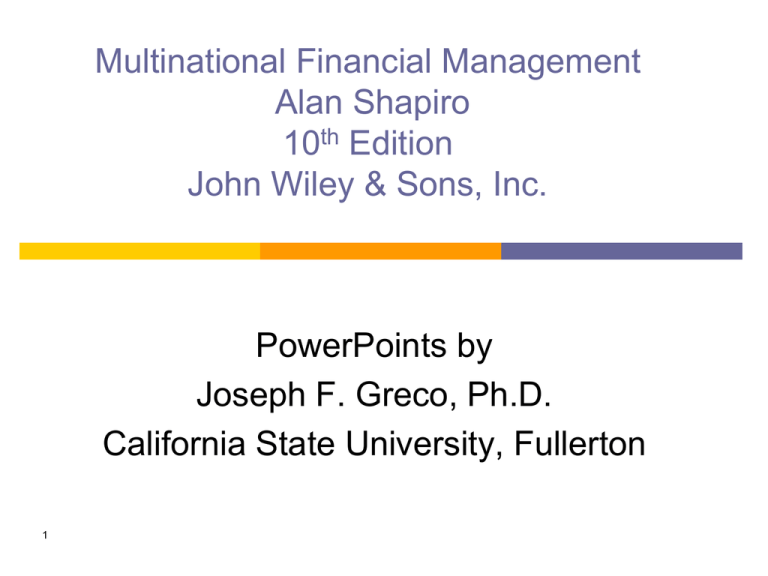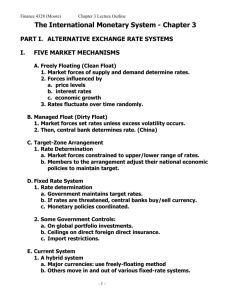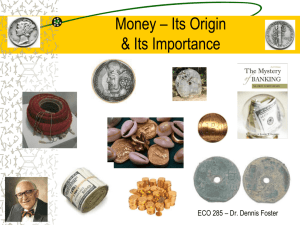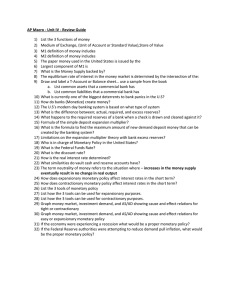
Multinational Financial Management
Alan Shapiro
10th Edition
John Wiley & Sons, Inc.
PowerPoints by
Joseph F. Greco, Ph.D.
California State University, Fullerton
1
CHAPTER 3
The International Monetary
System
ALTERNATIVE EXCHANGE RATE
SYSTEMS
I. FIVE MARKET MECHANISMS
A. Freely Floating (Clean Float)
1.
Market forces of supply
and demand determine
rates.
2.
Forces influenced by
a. price levels
b. interest rates
c. economic growth
3.
Rates fluctuate over time
randomly.
3
ALTERNATIVE EXCHANGE RATE
SYSTEMS
B. Managed Float (Dirty Float)
1. Market forces set rates unless excess
volatility occurs,
2. Then, central bank determines rate.
4
ALTERNATIVE EXCHANGE RATE
SYSTEMS
C. Target-Zone Arrangement
1. Rate Determination
a. Market forces constrained to upper and
lower range of rates.
b. Members to the arrangement
adjust their national economic
policies to maintain target.
5
ALTERNATIVE EXCHANGE
RATE SYSTEMS
D. Fixed Rate System
1. Rate determination
a. Government maintains target rates.
b. If rates threatened, central banks buy/sell
currency.
c. Monetary policies coordinated.
6
ALTERNATIVE EXCHANGE RATE
SYSTEMS
D. Fixed Rate System (con’t)
2. Some Government Controls:
a. On global portfolio
investments.
b. Ceilings on direct foreign
direct insurance.
c. Import restrictions.
7
ALTERNATIVE EXCHANGE RATE
SYSTEMS
E. Current System
1. A hybrid system
a. Major currencies: use freely-floating
method
b. Others move in and out of various fixedrate systems
8
A BRIEF HISTORY OF THE
INTERNATIONAL MONETARY SYSTEM
I.
THE USE OF GOLD
A.
B.
C.
Desirable properties
In short run: High production costs limit
short- run changes.
In long run: Commodity money insures
stability.
9
A BRIEF HISTORY OF THE
INTERNATIONAL MONETARY SYSTEM
II.
The Classical Gold Standard (1821-1914)
A.
Major currencies on gold standard.
1.
Involved commitment by
nations to fix the price of
domestic currency in terms of a
specific amount of gold.
10
A BRIEF HISTORY OF THE
INTERNATIONAL MONETARY SYSTEM
2.
3.
Maintenance involved the buying
and selling of gold at that price.
Disturbances in Price Levels:
Would be offset by the pricespecie*-flow mechanism.
* specie refers to gold coins
11
A BRIEF HISTORY OF THE
INTERNATIONAL MONETARY SYSTEM
3a.
Price-specie-flow mechanism
had automatic adjustments:
1.)
2.)
3.)
When a balance of payments surplus
led to a gold inflow;
Gold inflow led to higher prices which
reduced surplus;
Gold outflow led to lower prices and
increased surplus.
12
A BRIEF HISTORY OF THE
INTERNATIONAL MONETARY SYSTEM
III. The Gold Exchange Standard (1925-1931)
A.
B.
Only U.S. and Britain allowed to
hold gold reserves.
Others could hold both gold, dollars
or pound reserves.
13
A BRIEF HISTORY OF THE
INTERNATIONAL MONETARY SYSTEM
C.
Currencies devalued in 1931
- led to trade wars.
D.
Bretton Woods Conference
- called in order to avoid future
protectionist and destructive
economic policies
14
A BRIEF HISTORY OF THE
INTERNATIONAL MONETARY SYSTEM
IV. The Bretton Woods System (1946-71)
A. The Bretton Woods Agreement
1. U.S.$ was key currency;
valued at $1 = 1/35 oz. of gold.
2. All currencies linked to that price in
a
fixed rate system.
3. Exchange rates allowed to fluctuate
by 1% above or below initially set
rates.
15
A BRIEF HISTORY OF THE
INTERNATIONAL MONETARY SYSTEM
B. Collapse, 1971
1. Causes:
a. U.S. high inflation rate
b. U.S.$ depreciated sharply.
16
A BRIEF HISTORY OF THE
INTERNATIONAL MONETARY SYSTEM
V. Post-Bretton Woods System (1971-Present)
A.
Smithsonian Agreement, 1971
US$ devalued to 1/38 oz. of gold.
By 1973: World on a freely
floating exchange rate system.
17
A BRIEF HISTORY OF THE
INTERNATIONAL MONETARY SYSTEM
B.
OPEC and the Oil Crisis (1973-1974)
1.
2.
3.
4.
OPEC raised oil prices four fold;
Exchange rate turmoil resulted;
Caused OPEC nations to earn
large surplus B-O-P.
Surpluses recycled to debtor nations
which set up debt crisis of 1980’s.
18
A BRIEF HISTORY OF THE
INTERNATIONAL MONETARY SYSTEM
C.
Dollar Crisis (1977-78)
1.
U.S. B-O-P difficulties
2.
Result of inconsistent monetary
policy in U.S.
Dollar value falls as confidence
shrinks.
3.
19
A BRIEF HISTORY OF THE
INTERNATIONAL MONETARY SYSTEM
D.
The Rising Dollar (1980-85)
1.
2.
3.
U.S. inflation subsides as the Fed
raises interest rates
Rising rates attracts global capital to
U.S.
Result: Dollar value rises.
20
A BRIEF HISTORY OF THE
INTERNATIONAL MONETARY SYSTEM
E.
The Sinking Dollar (1985-87)
1.
2.
3.
Dollar revaluated slowly downward;
Plaza Agreement (1985)
G-5 agree to depress US$ further.
The Louvre Agreement (1987)
G-7agree to support the falling US$.
21
A BRIEF HISTORY OF THE
INTERNATIONAL MONETARY SYSTEM
F.
Recent History (1988-Present)
1.
2.
3.
1988 US$ stabilized
Post-1991 Confidence resulted in
stronger dollar
1993-1995 Dollar value falls
22
THE EUROPEAN MONETARY
SYSTEM
I.
INTRODUCTION
A.
The European Monetary System (EMS)
1.
A target-zone method (1979)
2.
Close macroeconomic policy
coordination required.
23
THE EUROPEAN MONETARY
SYSTEM
B.
EMS Objective:
to provide exchange rate stability to all
members by holding exchange rates within
specified limits.
24
THE EUROPEAN MONETARY
SYSTEM
C. European Currency Unit (ECU)
a “cocktail” of European currencies with specified
weights as the unit of account.
1.
Exchange rate mechanism (ERM)
each member determines mutually agreed
upon central cross-rate for its currency.
25
THE EUROPEAN MONETARY
SYSTEM
2.
Member Pledge:
to keep within 15% margin above or
below the central rate.
D. EMS ups and downs
1.
Foreign exchange interventions failed
due to lack of support by coordinated
monetary policies.
26
THE EUROPEAN MONETARY
SYSTEM
2. Currency Crisis of Sept. 1992
a. System breaks down
b. Britain and Italy forced to withdraw from
EMS
E.
Failure of the EMS
members allowed political priorities
to dominate exchange rate policies
27
THE EUROPEAN MONETARY
SYSTEM
F.
Maastricht Treaty
1. Called for Monetary Union by 1999
(moved to 2002)
2. Established a single currency: the
euro
3. Calls for creation of a single central EU
bank
4. Adopts tough fiscal standards
28
THE EUROPEAN MONETARY
SYSTEM
I.
Costs / Benefits of A Single Currency
A. Benefits
1. Reduces cost of doing business
2. Reduces exchange rate risk
B. Costs
1. Lack of national monetary flexibility.
29
Copyright 2014
John Wiley & Sons, Inc.
All rights reserved. Reproduction or translation of this work
beyond that permitted in section 117 of the 1976 United
States Copyright Act without express permission of the
copyright owner is unlawful.
Request for further
information should be addressed to the Permissions
Department, John Wiley & Sons, Inc. The purchaser may
back-up copies for his/her own use only and not for
distribution or resale.
The Publisher assumes no
responsibility for errors, omissions, or damages caused by
the use of these programs or from the use of the
information herein.








